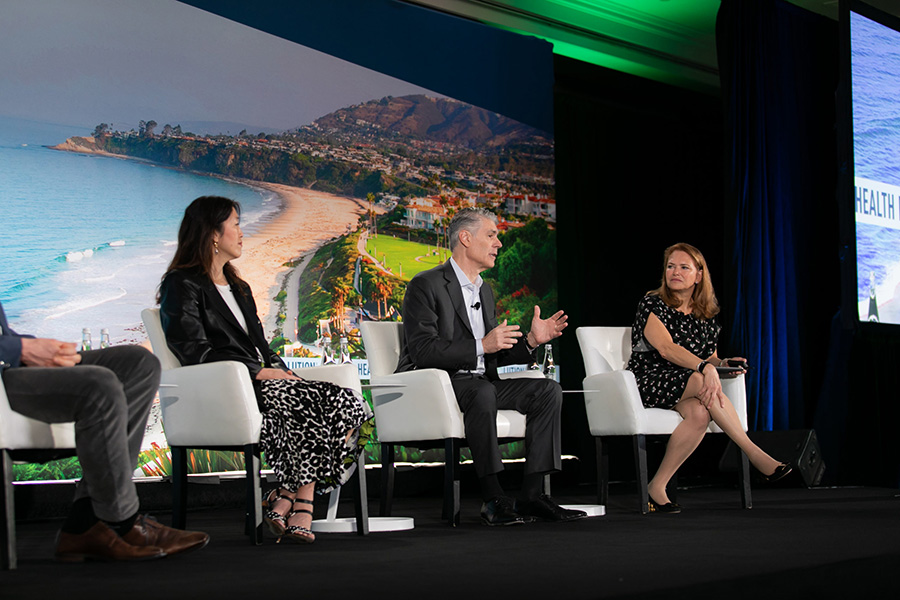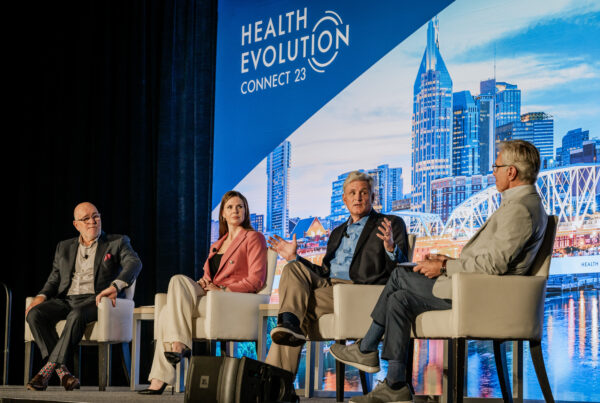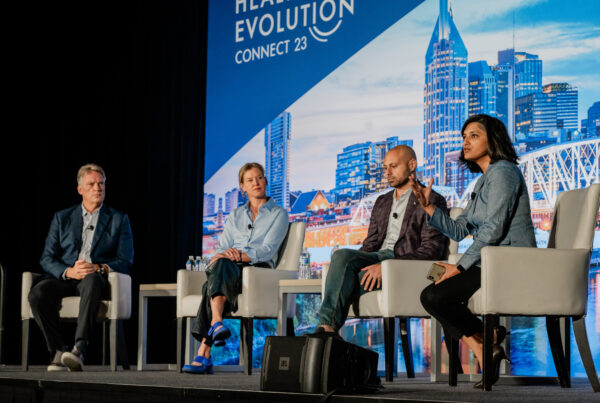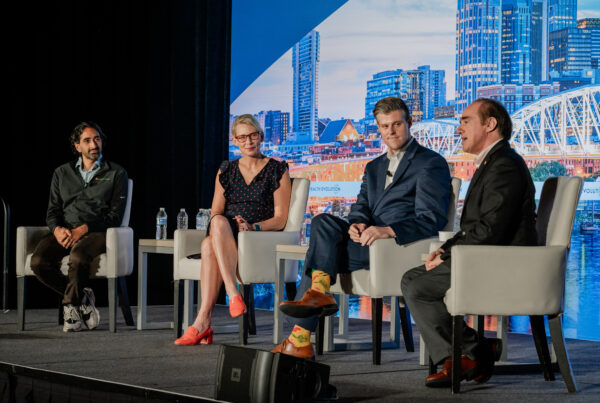Amid the continuing pandemic and civil injustice tragedies, widespread awareness of problems such as health inequities, staffing shortages, and systemic racism has increased.
That rising awareness has also created new priorities for CEOs leading health care and organizations in other industries. To discuss the new leadership agenda, executives joined in the Life Sciences Insights: Competing Priorities Coming out of COVID at the 2022 Health Evolution Summit.
Led by Amy Abernethy, MD, PhD, President of Clinical Studies Platforms, Verily, the Main Stage discussion included Joe Almeida, Chairman, President & CEO, Baxter, Julie Kim, President, U.S. Business Unit & U.S. Country Head, Takeda, Bernd Montag, PhD, CEO, Siemens Healthineers and Mike Mussallem, Chairman & CEO, Edwards Lifesciences.
The executives shared the following priorities:
-
- Humanizing themselves as CEOs
- Making the workforce more resilient
- Maintaining new and novel partnerships
- Improving relationships with patients
- Taking a stand on societal issues
Humanizing themselves as CEOs
In response to workforces becoming distributed during the pandemic, many CEOs held virtual town halls, circulated video messages or otherwise engaged with employees in new ways.
Montag, for instance, held virtual coffee breaks with employees.
“I felt, funnily enough, more connected than before,” Montag said. “Somehow, I think the virtual conversation can democratize things. You can talk about how you deal with your private situation and so on and so on. That was extremely helpful for me.”
Read all of our 2022 Summit articles
Almeida said it has been critical to speak with employees and make them feel safe to enable everyone to rise to the occasion.
“This was very scary to everyone and as a CEO you’re scared too,” Almeida said. “You have thousands of people out there.”
Abernethy said that virtual coffee breaks or other video meetings enable CEOs and executives to connect with team members and better understand how they live, which puts their individual circumstances into context.
“We were also taking care of our employees and family members and thinking about what this meant for their families,” Abernethy said.
Making the workforce more resilient
Edwards Lifesciences CEO Mike Mussallem said that one of the things the executive team learned quickly was that taking their hands off the wheel and trusting local leaders empowered them to make sound decisions. To do so, Edwards instituted two basic rules: one was “patients first” and the other was “keep employees safe and go figure it out.”
“You really have to rely on your culture when you get into a moment like we got into with COVID,” Mussallem said. “There were so many unexpected twists and turns and you tend to want to control things from headquarters. We decided to stand by our employees and our employees really stood by us. It was a real lesson for me personally.”
Empowering the workforce also helped to more closely align employees and corporate cultures that were divided by business units or regions before the pandemic.
“That’s an aspect we want to try to maintain as we come out of the pandemic and come back into the office, not going back into those geographic silos or functional or business silos but, instead, maintain some of that connection across the company,” Kim said. “That connection is a big part of resilience.”
Maintaining new and often novel partnerships
Among the noteworthy developments during the pandemic were the connections that life sciences companies made with their competitors as well as the public. Kim, for instance, played a critical role in establishing the CoVIg-19 Plasma Alliance, which enabled plasma companies to put competition aside in work to develop and test a plasma-derived therapy. Even though the trial did not deliver a therapy, it stands as a lesson about combining resources and expertise for the greater good.
“That level of collaboration among public and private entities as well as with patient groups and grassroots efforts hadn’t happened before with all of those different stakeholders. I hope we can carry that forward in terms of how you look at conducting clinical trials in a way that is more efficient and effective and potentially bringing treatments to patients faster,” Kim said.
Abernethy added that new approaches arose to clinical trials, notably multiple platform trials and that such controlled experimentation will benefit the industry moving forward.
That may prove to be both a necessity and an opportunity because, as Kim pointed out, during the pandemic a number of other clinical trials were disrupted, setback or even came to an abrupt halt.
Improving relationships with patients
Although the trend of moving more care into alternative settings, including the home, began long before COVID-19, the pandemic accelerated that work and has highlighted the value of doing so.
For some patients, in fact, the home is the most effective site of care, while others will continue to require a hospital or other care setting.
“It’s part of our responsibility to figure out where patients are and figure out how to meet them where they are versus forcing them to all come to us,” Kim said.
Moving care into the home offers a number of benefits as well. Notably, the ability to monitor a patient closely and provide intelligence to physicians about what a particular patient needs to avoid unnecessary and expensive emergency room visits.
“The whole thing is about how you create insights for physicians about the population of patients that they have so they can treat the right patients at the right time,” Almeida said.
Taking a stand on societal issues
All the leaders agreed that it is now critical to speak out about societal issues, whether it’s climate change, sustainability, racism or other social injustices.
Almeida recounted seeing the video of George Floyd being killed while in police custody and other tragic injustices with horror, knowing that Baxter employees were watching as well.
“To think that we are exempt and we’re just a company and we run the company for our patients, our employees and shareholders, and we move on, it doesn’t work. They want us to be part of it,” Almeida said. “Employees read the same things we do, they look at how we make products and they expect us to take a position, have a path forward, on issues such as global warming.”
Montag added that it’s “super important” for companies to do this because CEOs are well-positioned to be the voices that drive impactful change for difficult challenges such advancing equity and reducing climate change.
“Global companies can be a real counterbalance for the big themes of the planet,” Montag added. “Not because we think we are great, but who else should do it?”
That obligation is to serve employees but also to go beyond their own workforce and beyond the health care industry, Mussallem said, because inequities exist everywhere.
“There’s an obligation on us to try and be part of the solution, whether it’s how we conduct our clinical trials or what we can do to influence the system more broadly,” Mussallem added.
Conclusion
At the very least, the pandemic has served as a reminder that health care leaders need to show their human side, make the workforce more resilient, strengthen ties with patients and, when necessary, take a stand on issues that impact everyone, not just their own organization.
“We need to get it all right. It’s difficult when you go through something as traumatic as the pandemic and what that does to the system, a system that was already loaded. It punctuates that in a big way,” Mussallem said. Almedia added: “I hope this doesn’t go away as we move into an endemic state of this period and that we don’t lose all the things that I learned. I hope we don’t go back to the old habits.”










